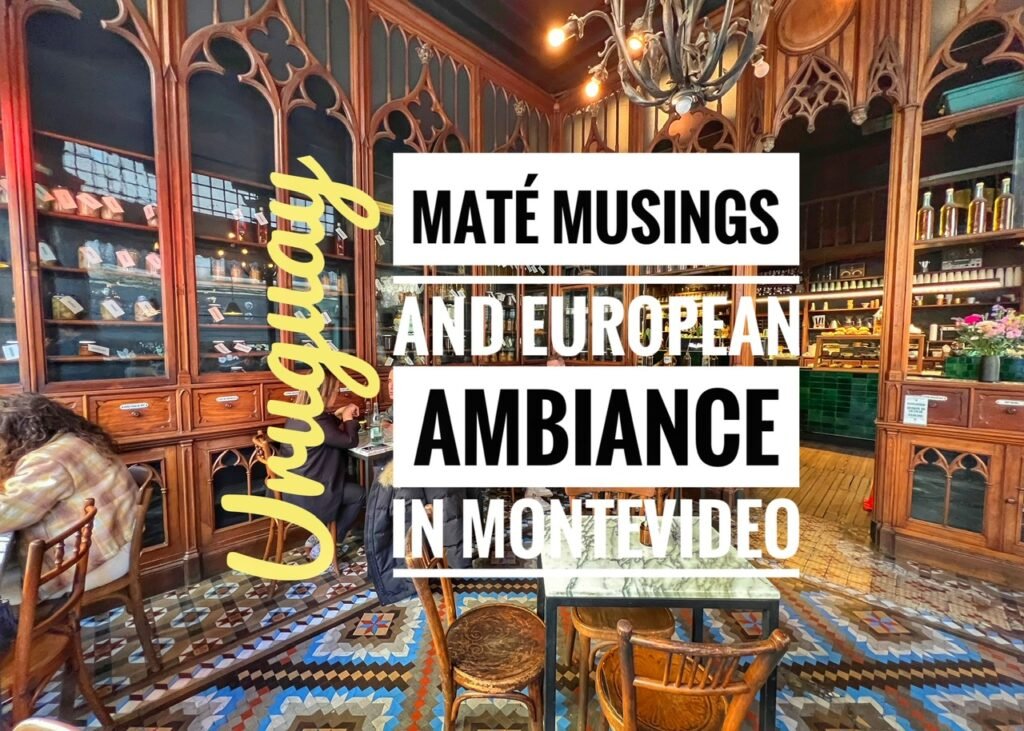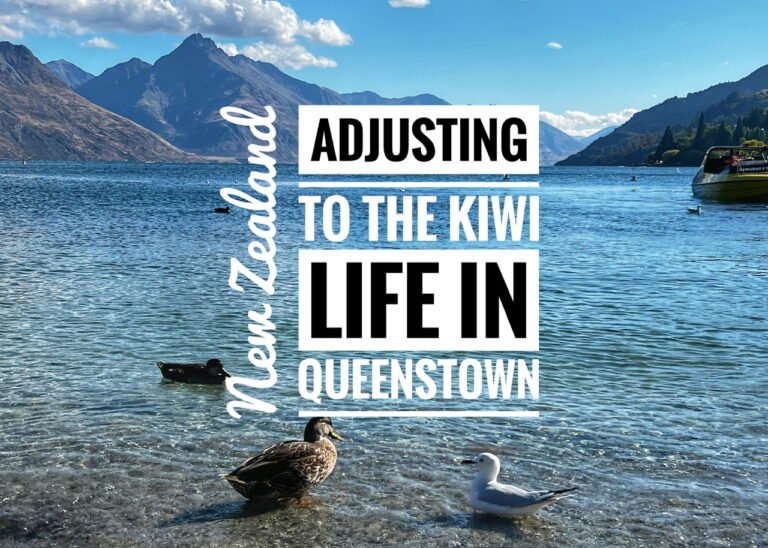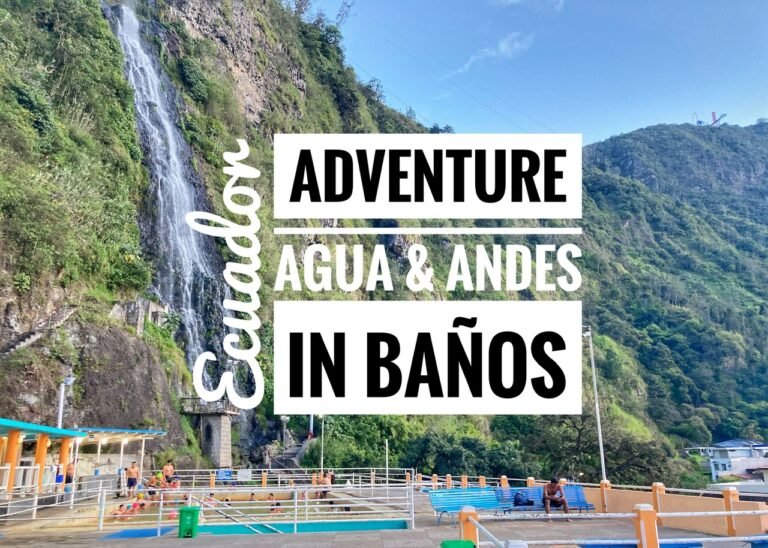
We read in a BBC article that Buenos Aires and Montevideo are constantly trying to “out-Europe” the other so it was no surprise when arriving to socially progressive Montevideo felt a lot like…arriving in Europe. Vanished are most Latin American vibes and in its place are layers of Art Deco and neoclassical buildings, LGBTQ couples holding hands, polished and clean city streets and a bizarrely quiet and chill vibe, at least on this winter day. The smell of cannabis constantly permeates the air and people cruise slowly around in puffy coats, often with elegant and leather bags used to carry thermoses and accessories for their famous maté drink.

Las Misiones, an emblematic and adorable cafe and brunch spot since 1907.

In La Farmacia Cafe, one can get a different kind of drug in this 19th Century pharmacy…caffeine and azúcar hits. With its intricate mosaic floor, emerald green countertops, and stunning built-in cabinets and drawers, it truly feels like stepping back into time.


We asked a local if we could walk in and buy a maté here too. The answer is no. Almost all maté is prepared and brought from home in each person’s own cup, although it’s normal to see “hot water” for sale in case you need a hotter upper.


We settled on a cookie sandwich packed with dulce de leche, which was far better, in our opinion, anyhow. However, we were so excited to eat it, we neglected to take a photo🤣

Independence Plaza, ringed with palm trees, where one can find a monument to José Gervasio Artigas, or the father of Uruguay. Uruguay won its independence between 1811 and 1828, following a four-way struggle between Portugal and Spain, and later Argentina and Brazil. We were lucky enough to celebrate their Independence Day with them during our six days in Uruguay.

Elaborate cups called matés or calabashes, traditionally made of gourds, and silver bombillas “straws” lined the windows of many store fronts. All are used to drink Yerba maté which is a traditional South American caffeine-rich infused herbal drink. The locals are obsessed with it and 85% drink it every day. (Maté Experience)

A selection of mouth-watering fruits and veggies down the street from where we stayed. We spent about $30 in groceries for two dinners and three breakfasts. Definitely not cheap here.



Inside the Mercado del Puerto, a grand 19th Century historic market which unlike most city markets, is mostly filled with carnivore-centric grills and restaurants. We visited early in the morning so there wasn’t a whole lot going on…

…except a few sellers trying to convince us a plate of overpriced meat would be a good idea, which we disagreed.

You can almost feel how cold and windy it was as we clasped hands with the Rio de la Plata, walking the city wall around the Ciudad Vieja (old city.)


Fishermen along the board walk…next to what appeared to be a peculiarly placed smoke stack. In reality, the Collector Respirator is the one of the last ventilators and a National Historic Heritage site today. From 1856 to 1913, it channeled the bad gases of the sewer from the city the ocean. Or, basically, it cut the stink in half.

While the perimeter is not the prettiest for sightseeing, the Port of Montevideo is one of the major shipping ports of South America and plays a very important role in the economy of Uruguay.

Nobody wants to play on the basketball courts at sunset in this city…

The pedestrian only street in which we stayed in the heart of Ciudad Vieja.

Many tree lined parks, many with beautified fountains.


The cultural and social center of Montevideo is Club Uruguay, a “gentleman’s club” dating from 1888 in what is supposed to be an architectural marvel inside. Greg tried to prance in as if he were one of these gentlemen, but of course we quickly got swatted away from this private establishment.

Grabbing a sunny yellow lunch at one of the cheaper restaurants we could find…Sabor Peruana, which like in Peru offered Menu del Dias. Unlike in Peru, it cost $7.50 each instead of $3, but similarly, was pretty tasty.

Depending on which way you enter, the Gateway of the Citadel serves as the entrada to Independence Square. It’s one of the few remaining parts of a Spanish citadel that was destroyed in the early 1800s when Uruguay became an independent nation. It was built by the Spaniards to help them gain control of the Rio de la Plata, the border between Uruguay and Argentina.

According to Atlas Obscura, “the Palacio Salvo, inaugurated in 1928, appeared in the city landscape as a strange creature, one that has both delighted and disgusted architecture buffs for decades. Designed by the italian architect Mario Palanti, the building had everything you could imagine, from a cinema to a hotel. The palace was originally topped with a lighthouse with a parabolic mirror reaching approximately 100km, but the light was later removed in favor of an antenna that gave the 27-floor building its eventual height of 100 meters. With this addition it was once thought to be the tallest building in South America, but the antenna has since been removed, demoting it to simply a fantastic display of architecture. Originally intended as a luxury hotel, the palace never managed to fulfill that purpose, and acts instead as a very elaborate collection of private residences and offices.”


In an opulent 19th Century mansion sits the Museum of the Gaucho near an interesting blend of architecture…


The Edificio Rex apartment complex has gorgeous French-style balconies sandwiched between elaborate ribbons of golden ornamentation. Too bad a Starbucks deflects from its look at ground zero. Guess it’s the trend around here. 🤣


Now that is one fancy maté purse! Price tag says $119. How you treat yo-self if you’re uruguayo, evidently! And…if you can’t afford the fancy bag, you MUST at LEAST have a termos for your hot water! Uruguay is the largest consumer of maté per capita, consuming around 19 liters per year. However, interestingly, Uruguay grows very little of their own maté. The majority comes from their maté mates in Argentina.

Who knew it was such a fashion accessory?!


We’ve seen lots of bridges around the world plastered with locks of love but this fountain might take the cake in shock, or rather lock-power. When the owners of Bar Facal, one of the most famous restaurants in the city, installed Fuente de los Candados on their street corner, they had no idea it would become one of the city’s most enduring symbols of love.
According to Atlas Obscura, the owners imported the small volcanic stone fountain from Puerto Vallarta in Mexico and it sat in storage for 15 years until they finally decided to install it outside the bar. Before long it was draped and drizzled with rusty remembrances of love from top to bottom. We’ve never seen one quite like it.

Many pages of history blanket this scene in architectural styles.


More pedestrian streets, where people tend to sell a little bit of everything.


We’ve learned you can tell a lot about a country by its national dish. Uruguay’s is the chivito sandwich…made of sliced beefsteak, mozzarella, ham, boiled eggs, tomatoes, mayonnaise and black or green olives. And the fact that they had a vegetarian version certainly speaks to Uruguay’s progressive nature. It was also certainly the only time we’ve ever seen a sign in a restaurant reminding people of the dangers of excess salt.

Speaking of progressive, for two nights we stayed at a cozy little corner in the Ciudad Vieja called Casa Vegana, which is “a vegan meeting space which celebrates cultural diversity, gender expressions, as many sexual orientation as there are, and a free exchange of ideas.”

We met some very lovely people there, including Ivan and his sweet mama, María Luisa who are Mexicans living in Uruguay for six years. Ivan is a social activist for animal rights, which undoubtedly is not an easy issue to confront in a beef-adoring environment like Uruguay. We appreciated his efforts and his welcoming home very much.


Plus it had a fantastic rooftop terrace to enjoy some wine on. Our colorful room had at least 15 foot ceilings, was about $28/night, so we were still able to keep it close to budget.

While in Montevideo, we also learned a bit about Carnval. Yes….Carnaval. Everyone knows about the annual Carnaval in Rio de Janiero, but, as we found out at the Museo Carnaval, Uruguay has a rendition of their own with equally brilliant and colorful costumes.



Uruguayan Carnaval is a festival that takes place every year in Uruguay from mid January to late February. The Carnaval draws root from candombe, Murga and tablados, which are forms of expression of Uruguayan culture through dance and music.



From its conception, the Uruguayan Carnaval has evolved into a dance parade in which different comparsas, groups of street performers in Latin American festivals, play the drums and dance at the “Desfile Inaugural del Carnaval” and “Desfile de Llamadas” parade. (Wikipedia/Museum info)

The biggest carnival celebrations are in the capital Montevideo and can last up to 40 days.


Getting back to the bus station was easy. We hopped on city bus CE1 a few minutes walk from Casa Vegana for $1/each.Arriving back to the polished Tres Cruces station and onto the next destination…



